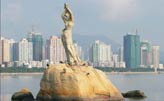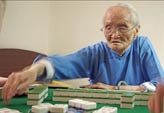Cover Story
Questions remain over safety of bottled water
Updated: 2011-08-16 07:55
By Wu Wencong (China Daily)
![A worker, wearing a hygiene mask and hair covering, examines containers at a bottled water plant in Beijing's Chaoyang district on Monday. [Zhang Tao / China Daily] Questions remain over safety of bottled water](../../attachement/jpg/site1/20110816/0013729e48090fb3f3c80c.jpg) |
|
A worker, wearing a hygiene mask and hair covering, examines containers at a bottled water plant in Beijing's Chaoyang district on Monday. [Zhang Tao / China Daily] |
Brand reliability provides buyer with no guarantee of product's purity, reports Wu Wencong in Beijing.
The era of drinking water from the tap has been over for years, says Li Fuxing, director of the Beijing Institute of Public Health and Drinking Water. But there are no guarantees that the water you take from a dispenser is safe, either.
There are too many opportunities for contamination, in every step of the process, from water source to the 18.9-liter container that is delivered to your home or office.
Choosing a relatively reliable brand can lower the risk. But before that a thorough understanding of drinking water and the dispensing industry is more effective than buying by price or brand name.
"In China, people's level of knowledge about drinking water is unbelievably low," said Li, who has been conducting research in water and health for almost 20 years.
They don't know, for example, that they should drink eight to 10 glasses of water a day.
He reached that conclusion based on an online survey, released in March, that drew about 70,000 responses - 80 percent of which showed ignorance of the basics of water and health. Still, Li said, the proliferation of choices in drinking water shows that consumers want to do the healthy thing.
First, they know that many sources of drinking water are fouled by industrial waste or other sources of pollution. On Sunday, for example, water experts arrived in Qujing, Yunnan province, to investigate after highly toxic waste was dumped at a water source - not a rare occurrence.
Second, Li has said previously that the delivery of treated water often means traveling through pipes that could be 60 years old and risks from byproducts of disinfectant chlorine.
So 10 million people subscribe to water dispenser services, spending more than 30 billion yuan ($4.7 billion) annually, Li said. Asia tops the world in the growing pace of the industry, and China leads the way with a rate of roughly 20 percent a year.
In some cities, Li said, more than 60 percent of households get their drinking water delivered in the big bottles, sometimes called barrels. Yet on July 6, the capital's industry and commerce administration reported that 31 water brands had failed regular safety checks. All exceeded the allowable count of aerobic bacteria; one brand, Liquan, was 9,000 times over the limit.
In an interview with China Daily, Li broke down the hidden dangers in the production and distribution processes for water that comes in "barrels".

Specials

Jewel of the south
Zhuhai in South China has a wealth of natural allure that is open for business.

China in vogue
How Country captured the fascination of the world's most powerful fashion player

More than just a game
Mahjong is a deep-rooted cultural tradition that touches every level of society